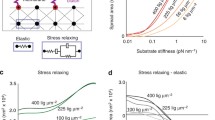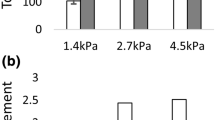Abstract
Cells generate traction stresses against their substrate during adhesion and migration, and traction stresses are used in part by the cell to sense the substrate. While it is clear that traction stresses, substrate stiffness, and cell area are related, it is unclear whether or how area and substrate stiffness affect force generation in cells. Moreover, multiple studies have investigated traction stresses of single cells, but few have focused on forces exerted by cells in contact, which more closely mimics the in vivo environment. Here, cellular traction forces were measured where cell area was modulated by ligand density or substrate stiffness. We coupled these measurements with a multilinear regression model to show that both projected cell area and underlying substrate stiffness are significant predictors of traction forces in endothelial cells, and interestingly, substrate ligand density is not. We further explored the effect of cell–cell contact on the interplay between cell area, substrate stiffness, and force generation and found that again both area and stiffness play a significant role in cell force generation. These data indicate that cellular traction force cannot be determined by cell area alone and that underlying substrate stiffness is a significant contributor to traction force generation.







Similar content being viewed by others
References
An, S. S., et al. Do biophysical properties of the airway smooth muscle in culture predict airway hyperresponsiveness? Am. J. Respir. Cell Mol. Biol. 35(1):55–64, 2006.
Califano, J. P., and C. A. Reinhart-King. A balance of substrate mechanics and matrix chemistry regulates endothelial cell network assembly. Cel. Mol. Bioeng. 1(2–3):122–132, 2008.
Califano, J. P., and C. A. Reinhart-King. Exogenous and endogenous force regulation of endothelial cell behavior. J. Biomech., 2009. doi:10.1016/j.jbiomech.2009.09.012.
Chen, C. S. Mechanotransduction—a field pulling together? J. Cell Sci. 121(Pt 20):3285–3292, 2008.
Dembo, M., et al. Imaging the traction stresses exerted by locomoting cells with the elastic substratum method. Biophys. J. 70(4):2008–2022, 1996.
Dembo, M., and Y. L. Wang. Stresses at the cell-to-substrate interface during locomotion of fibroblasts. Biophys. J. 76(4):2307–2316, 1999.
du Roure, O., et al. Force mapping in epithelial cell migration. Proc. Natl Acad. Sci. USA 102(7):2390–2395, 2005.
Engler, A., et al. Substrate compliance versus ligand density in cell on gel responses. Biophys. J. 86(1 Pt 1):617–628, 2004.
Engler, A., L. Richert, J. Wong, C. Picart, and D. Discher. Surface probe measurements of the elasticity of sectioned tissue, thin gels and polyelectrolyte multilayer films: correlations between substrate stiffness and cell adhesion. Surf. Sci. 570:142–154, 2004.
Georges, P. C., and P. A. Janmey. Cell type-specific response to growth on soft materials. J. Appl. Physiol. 98(4):1547–1553, 2005.
Guo, W. H., et al. Substrate rigidity regulates the formation and maintenance of tissues. Biophys. J. 90(6):2213–2220, 2006.
Lemmon, C. A., C. S. Chen, and L. H. Romer. Cell traction forces direct fibronectin matrix assembly. Biophys. J. 96(2):729–738, 2009.
Lemmon, C. A., et al. Shear force at the cell-matrix interface: enhanced analysis for microfabricated post array detectors. Mech. Chem. Biosyst. 2(1):1–16, 2005.
Li, B., et al. Spatial patterning of cell proliferation and differentiation depends on mechanical stress magnitude. J. Biomech. 42(11):1622–1627, 2009.
Li, Y., Z. B. Hu, and C. F. Li. New method for measuring poisson ratio in polymer gels. J. Appl. Polym. Sci. 50(6):1107–1111, 1993.
Lo, C. M., et al. Cell movement is guided by the rigidity of the substrate. Biophys. J. 79(1):144–152, 2000.
Marganski, W. A., M. Dembo, and Y. L. Wang. Measurements of cell-generated deformations on flexible substrata using correlation-based optical flow. Methods Enzymol. 361:197–211, 2003.
Munevar, S., Y. Wang, and M. Dembo. Traction force microscopy of migrating normal and H-ras transformed 3T3 fibroblasts. Biophys. J. 80(4):1744–1757, 2001.
Nelson, C. M., et al. Emergent patterns of growth controlled by multicellular form and mechanics. Proc. Natl Acad. Sci. USA 102(33):11594–11599, 2005.
Ott, R. L., and M. Longnecker. An Introduction to Statistical Methods and Data Analysis. Pacific Grove, CA: Duxbury Press, 2001, 1184 pp.
Paszek, M. J., and V. M. Weaver. The tension mounts: mechanics meets morphogenesis and malignancy. J. Mammary Gland. Biol. Neoplasia 9(4):325–342, 2004.
Paszek, M. J., et al. Tensional homeostasis and the malignant phenotype. Cancer Cell 8(3):241–254, 2005.
Pless, D. D., et al. Specific cell adhesion to immobilized glycoproteins demonstrated using new reagents for protein and glycoprotein immobilization. J. Biol. Chem. 258(4):2340–2349, 1983.
Reinhart-King, C. A. Endothelial cell adhesion and migration. Methods Enzymol. 443:45–64, 2008.
Reinhart-King, C. A., M. Dembo, and D. A. Hammer. Endothelial cell traction forces on RGD-derivatized polyacrylamide substrata. Langmuir 19(5):1573–1579, 2003.
Reinhart-King, C. A., M. Dembo, and D. A. Hammer. The dynamics and mechanics of endothelial cell spreading. Biophys. J. 89(1):676–689, 2005.
Reinhart-King, C. A., M. Dembo, and D. A. Hammer. Cell-cell mechanical communication through compliant substrates. Biophys. J. 95(12):6044–6051, 2008.
Tsai, J., and L. Kam. Rigidity-dependent cross talk between integrin and cadherin signaling. Biophys. J. 96(6):L39–L41, 2009.
Wang, N., et al. Micropatterning tractional forces in living cells. Cell Motil. Cytoskeleton 52(2):97–106, 2002.
Wang, Y., et al. Integrins regulate VE-cadherin and catenins: dependence of this regulation on Src, but not on Ras. Proc. Natl Acad. Sci. USA 103(6):1774–1779, 2006.
Wang, Y. L., and R. J. Pelham, Jr. Preparation of a flexible, porous polyacrylamide substrate for mechanical studies of cultured cells. Methods Enzymol. 298:489–496, 1998.
Yeung, T., et al. Effects of substrate stiffness on cell morphology, cytoskeletal structure, and adhesion. Cell Motil. Cytoskeleton 60(1):24–34, 2005.
Zemel, A., and S. A. Safran. Active self-polarization of contractile cells in asymmetrically shaped domains. Phys. Rev. E Stat. Nonlin. Soft Matter Phys. 76(2 Pt 1):021905, 2007.
Acknowledgments
This work was supported by a Scientist Development Grant from the American Heart Association and funding from the National Institutes of Health to CRK, and a Grant-In-Aid of Research from Sigma Xi, The Scientific Research Society to JPC.
Author information
Authors and Affiliations
Corresponding author
Rights and permissions
About this article
Cite this article
Califano, J.P., Reinhart-King, C.A. Substrate Stiffness and Cell Area Predict Cellular Traction Stresses in Single Cells and Cells in Contact. Cel. Mol. Bioeng. 3, 68–75 (2010). https://doi.org/10.1007/s12195-010-0102-6
Received:
Accepted:
Published:
Issue Date:
DOI: https://doi.org/10.1007/s12195-010-0102-6




